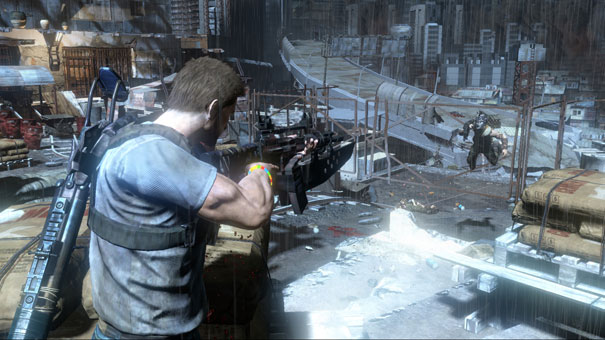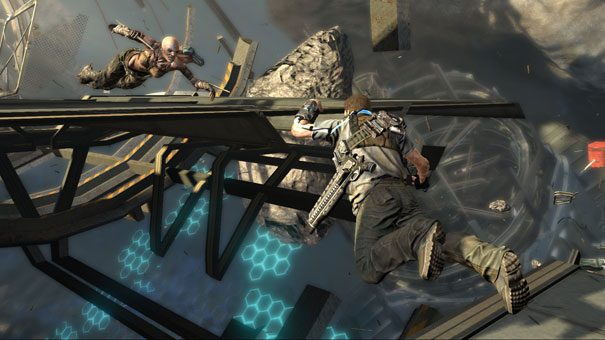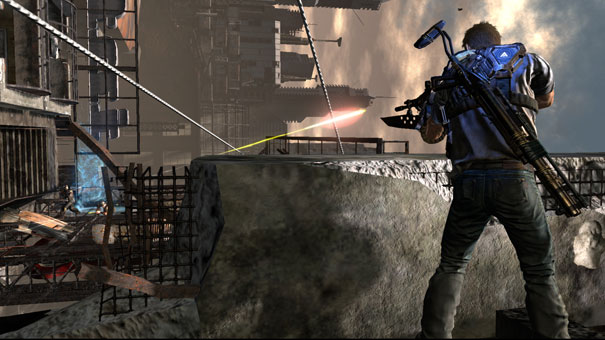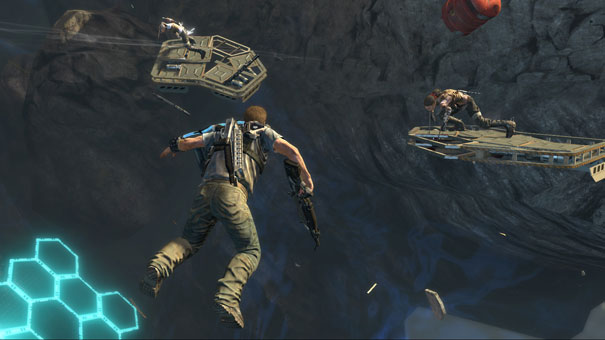At first glance, Inversion comes across as a terribly obvious Gears of War clone with a gimmicky anti-gravity mechanic thrown in. As you play through the campaign, you realise your first impression was spot-on. Inversion isn’t unplayable per se and it does have a few fleeting moments of enjoyment, but overall feels like a lacklustre shooter that can never capitalise on its concept.

Inversion takes place in the near future, where a mysterious alien race called the Lutadores have invaded Earth, enslaved its people and messed up gravity big time. You are Davis Russel, a maverick cop who takes a personal interest in this invasion as his wife is killed and daughter kidnapped by these beefed up, incoherent barbarians. He’s aided in this noble endeavour by his partner Leo Delgado, who by the way, can be controlled by another player as this game offers online co-op. The game really tries to make you connect with Russel and feel his anguish as he searches for his daughter, but clichéd dialogue, a predictable plot and wafer-thin characters prevent you from doing so. It also really wants to offer you an Uncharted-esque cinematic experience by blending (an insane amount of) cut-scenes and gameplay into one seamless package, but the transitions end up feeling extremely jarring and disorienting.
Combat is what you would expect from a run-of-the-mill cover-based third person shooter; you take cover, pop dudes in the face, and move on. I have no issue with this sort of a tried and tested approach as long as it’s handled well. In Inversion, unfortunately, the combat ends up feeling clunky. Gunplay is sloppy and the cover system is not as tight and responsive as you’d like, so you’ll end up dying just because Russel didn’t snap into cover when you wanted him to. Not helping matters at all is the fact that Russel can die in the blink of an eye (it’s like the dude is made of glass). Oh, and let’s not forget the unimaginative and tedious boss fights that are thrown at you (multiple times in some cases) just to make the game seem tougher. Hurray for artificial and totally unnecessary difficulty spikes!

A few chapters in, Russel gains access to the Gravlink – Lutadore technology that allows him and Delgado to manipulate the forces of gravity. This definitely elevates gameplay from ‘boring’ to ‘sort of interesting’. Using the Gravlink, players can either reduce gravity or amp it up tenfold. Reducing it causes enemies and certain objects to float weightlessly in the air so you can use this to forcefully remove enemies from cover and then pump them full of lead. Or you could grab floating objects/debris and toss them towards enemies. It’s not revolutionary by any means, but it sure is fun. And once you upgrade the Gravlink, you can start throwing heavier objects like cars onto people, and that’s always a plus point in my books. Increasing gravity on enemies will pin them down for a small window of time during which you can shoot them in the face. Targeting heavy gravity at larger objects like crates will rip them out from their foundations, creating makeshift cover for players.
As cool as making your own cover sounds, it is sadly all scripted, which means you can only do so when the game wants you to. But you know what; even if you were off the leash to use the game’s gravity mechanics any way you seemed fit, the fact is that because Russel can die so fast, you’re forced to play the game very carefully. This is in stark contrast to the whole ‘go out and throw stuff around with reckless abandon’ vibe this game was probably going in for. Plus, manipulating gravity behind cover really doesn’t work too well, so more often than not, you’ll be spending most of your time in Inversion behind cover.

The game, however, will rip you out of cover with certain zero gravity situations, which it does quite well. These work a lot like Dead Space 2, where you can glide across the map, taking cover behind floating objects. It feels disorienting (in a good way) when the wall or ceiling suddenly becomes the floor as your world quite literally is tuned around. Combat during these sections is also quite intense and is a much needed respite from usual run and gun action. Unfortunately, these sections don’t crop up as often as I would have liked. And I know it’s being a bit ambitious, but allowing players to flip the game world upside down instead of doing it for them would have been totally freaking awesome.
Inversion is not a bad looking game, but the Xbox 360 version does suffer from quite a bit of stuttering. Even though the art style is your conventional post-apocalyptic scenario, it does look good in places, offering players some pretty impressive backdrops to fight against. The level design especially shines during certain zero gravity sections when you realise you’re on the wall of a building and can see a battle taking place on the ground in front of you. It’s moments like these that make Inversion stand out from the crowd, but just as you start thinking “Hey, this game’s not all that bad”, it slaps you in the face and sucks you back into its dull combat.

Conclusion
Like Darksiders, Inversion could have been a game that’s inspired by various titles from the same genre, capitalising on elements that made them all fun to play. There are a few moments like this in the game, but they are few and far between. Most of the time, you’ll be left with a rather average shooter that won’t turn your world upside down.




